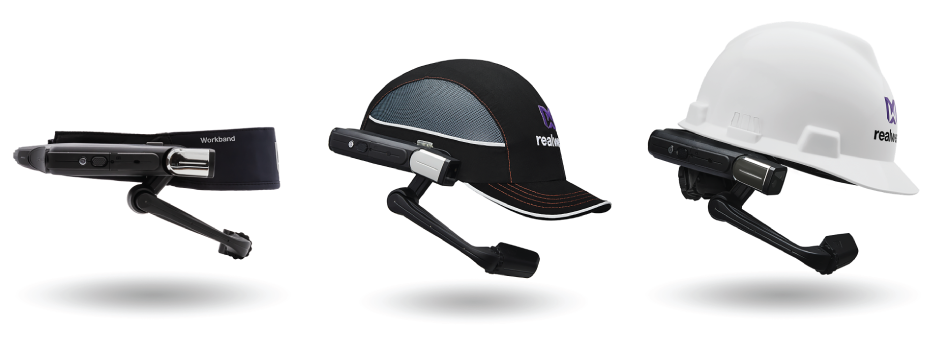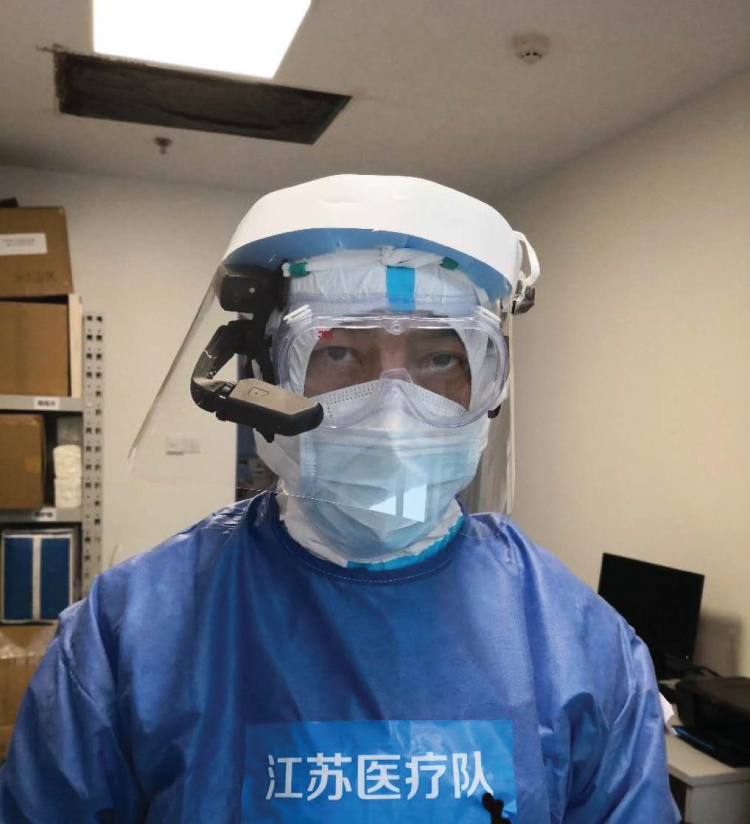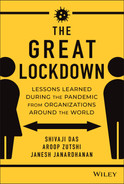CHAPTER 12
RealWear, Inc
By Andrew E. Chrostowski (Chairman and CEO), Rocky Scales (Executive Vice President, Global Sales), and Aaron Cohen (Director of Communications)
About RealWear
RealWear, the world's leading maker of industrial-strength, assisted-reality, hands-free devices for frontline workers, has been providing in-situ information and in-the-field training with software and hardware since 2016. We catapulted quickly into prominence by creating a wearable computer that operates flawlessly in extremely noisy industrial environments, freeing a worker to focus on the task at hand. For example, the RealWear HMT-1 assisted-reality (AR) device is designed to maintain full situational awareness while allowing communication and collaboration with the team. (See Figure 12.1)
For us, it was never just about technology. From the very beginning, our mission has been to empower, engage, and elevate people. We believe that connected workers are inherently more engaged with their business and customers; that having access to relevant and critical information, hands-free, empowers workers to do their jobs more safely and productively; and that these two things combined elevate the frontline worker's personal performance for the enterprise.
In the early years of our operation, the industry was still trying to define itself. The Gartner Hype Cycle1 had pushed consumer expectations for augmented reality into the “trough of disillusionment” as experiments and implementations failed to deliver, leaving an opportunity for a rugged industrial solution. ABI Research now projects that smart glasses hardware unit shipments in the industrial and healthcare sectors will grow globally by a factor of 12.8 between 2020 and 2025.2 Nevertheless, we saw several key competitors shutter due to a focus on the hype around technology rather than on driving value; in early 2019, three AR companies failed within the space of four weeks alone.3

FIGURE 12.1 The device can be connected to a variety of head-mounting options.
Source: RealWear
In contrast, we maintained a laser focus on the safety and needs of industrial frontline workers. Our hardware was ready, as was our hands-free software platform; the solution had been proven in real-world use. From the outset, we structured the company for scale, including establishing strong relationships with resellers to support large industrial customers. We were certified in more than 60 countries4 and a dozen languages5 and had strong partnerships with Microsoft, Cisco, and Zoom.6 An impressive number of global companies had embraced and deployed RealWear for their workforce, including BMW, Volkswagen Commercial Vehicles UK, Lexus, China's State Grid, Groupe PSA, and Italgas. Our products are uniquely designed to be compatible with personal protective equipment (PPE) such as hard hats, bump caps, hearing protection, and even N95 respirators and surgical masks. Hundreds of app developers have now built and optimized voice-enabled apps just for the device, creating an ecosystem that gives RealWear an appeal across diverse industries.
Incredibly, the pandemic would ultimately serve to push us across the chasm of technology adoption,7 but we thrived on “the other side” because we already had in place the structures, culture, team, and ecosystem needed to succeed.
The Early Days of the Pandemic
We gained early insight into the pandemic through our joint venture in China. RealWear China's focus as the virus spread was to help the medical and first-responder community and help ensure business continuity for organizations in the affected areas. In addition to donating a number of devices to minimize the spread of COVID-19, we partnered with Tencent, one of the world's most prominent technology companies, to launch a joint solution designed to help governments, companies, and organizations recover their operation, specifically in the areas of employee management, customer service, and plant maintenance. The innovative solution leveraged AI and big data capabilities from Tencent Cloud together with our device to enable employees to receive faster zero-contact temperature screening, self-guided training and digital workflow, and remote video support for production, service and plant maintenance. Everything was done remotely, from solution concept to release.8
In Wuhan, the Tongji Hospital became the first to use the system's real-time audio and video capabilities to lower the risk of infection by enabling frontline medical teams to communicate directly with senior staff members working outside the hot zone. The chief physician and specialized experts alike were able to propose a diagnosis and treatment plan, helping speed recovery, all while working remotely. With PPE in short supply, the HMT-1 assisted-reality device also allowed the hospital – and other hospitals that later adopted our technology – to minimize the number of times physicians needed to enter the isolation areas, reducing the protective gear required. It also increased their capacity to treat patients and reduced the critical constraint of physician capacity during the pandemic – something that has been of critical value to healthcare systems worldwide during the pandemic. (See Figure 12.2.)

FIGURE 12.2 Medical professionals in China used HMT-1 during the pandemic.
Source: RealWear China
All the while, we began experiencing the early effects of the pandemic on our business. There was a lot of uncertainty about how the pandemic would affect our customers' buying behaviors and whether they would freeze their discretionary and CapEx budgets. This uncertainty, plus our low cash position, caused us to tighten our budgets to ensure that we could survive and position ourselves for future growth. We immediately launched into negotiations with our manufacturer to reduce output; we needed to hold less inventory and increase turns, thereby increasing our available cash and reducing the cash tied up in inventory. These successful negotiations were a central piece of making it through this challenging period.
Navigating the Great Lockdown: The Race to Adapt
To make things even more interesting, we were already going through significant changes unrelated to the pandemic. As the company evolved from an early-stage startup to a company in full-tilt growth mode, both the leadership team and processes needed to evolve. That evolution led to the restructuring of our board of directors in March 2020. Andrew Chrostowski was named chairman and acting CEO, and RealWear cofounder Sanjay Jhawar was appointed to the board.
Entering the pandemic, our cash position was extremely low, and we were burning substantial cash from operations. The situation required a complete turnaround initiative. Our new leadership team acted decisively to protect the company. In the early months of the pandemic, we put product development on hold, eliminated paid marketing efforts and travel, and negotiated with several key vendors to reduce or defer payments significantly.
We also moved swiftly to conduct a round of layoffs, a difficult move but required, to match our burn rate to what could be uncertain economic reactions to the pandemic. The layoffs were also designed to guard against having to lay off additional workers down the road. During that painful process, we were proud to be able to preserve the jobs of all of the special needs workers we employed.
Like many in the business world, we proactively pivoted to a remote model to protect our employees and put in place key safety measures, including masks and sanitation protocols, for those workers who would still be going into the office; we were designated early on as an essential critical infrastructure company because we made products for manufacturing, healthcare, and other essential functions.
We also turned our focus inward. Just as we want our solutions to empower, elevate, and engage our customers' frontline workers, we were committed to doing the same for our employees. In the early weeks of the pandemic, we made concerted efforts to check in personally with team members across the organization to see how they were handling this unprecedented change. We held small group meetings to find out what our employees liked about their jobs, what they would change, and what they needed to be happier and more productive. As a result, we moved our “all-hands” calls from a quarterly to a weekly frequency to improve the communication that was even more important during the most critical transition period before settling into a new, monthly cadence. We also held a video contest to share life and productivity hacks to ensure that our teams could balance the new work-life challenges the pandemic created. Our focus on people kept our culture strong and morale high.
Beyond RealWear, the work-from-home movement globally acted as a massive catalyst to turbocharge digital transformation as companies embraced remote collaboration tools like Microsoft Teams, Cisco Webex, Slack, and Zoom.
Almost overnight, we found our solutions on the world stage. The challenges of managing the pandemic led existing and new customers alike to accelerate their adoption of telepresence and other solutions for frontline and first-line workers. We worked with Microsoft for about two years to optimize its Teams solution for our hands-free platform. The results of this effort were announced by the Microsoft chairman and CEO himself, Satya Nadella, at the 2020 Inspire Conference, where he highlighted how our combined solution was used by Honeywell to commission a plant automation system entirely remotely, with dozens of engineers collaborating and signing off on the project without ever having to travel to the site. Purchases of HMT-1 wearable computers that supported the COVID-19 battle increased to 35% of sales in six weeks.
For companies like Goodyear, the Microsoft announcement was a tipping point. Goodyear had a mature Teams deployment, and they understood its benefits and didn't want to introduce a new collaboration tool. The moment Teams became available on RealWear was the deciding factor. When they added the device to Teams meetings, like any other device, adoption of the RealWear solution moved quickly.
While RealWear already had the structures, culture, team, and ecosystem in place to support large-scale expansion, we had to figure out how to do business remotely, just as every other organization did. Our sales and customer support teams logged long hours as we all improvised, experimented, and adjusted as a long consultative sales cycle turned into the need to simply take orders and support customers in evolving use cases.
We were fortunate to have supportive investors, namely CVC, which provided a bridge loan to help us get through this difficult period. We worked quickly to put a line of credit in place to free up additional cash. As our revenue increased substantially and we continued our efforts to keep inventory low, we produced substantial cash to operate and expand the business. We opened new offices and shifted to a third-party logistics provider to support continued growth driven by new hardware products, cloud, and recurring revenue, and the expansion of our ecosystem and use cases through large software partners.
And we did it all with three transformative goals in mind – goals that guided our everyday actions, discipline, and decision-making: to reach USD 1 billion in revenue, be IPO-ready in how we operated, and become a market leader with a recognized brand name at the industrial front edge. Among the actions we took toward these goals were:
- Opening a customer experience center in Dubai
- Adding local offices in the Netherlands, Singapore, Germany, the UK, Japan, Australia, and Korea
- Adding 24/5 global, rapid-response support, including over holidays
- Rapidly growing sales staff in high-demand regions
- Broadening sales channels through global distribution and resellers
- Leveraging customers as advocates
- Making significant investments in marketing to increase awareness of the RealWear brand
The rebound was palpable. Sales in 2020 tripled over 2019, and we reached an important milestone in early 2021: that of having shipped wearable devices to more than 3,000 unique enterprise customers worldwide in a wide range of industries. And a year after Microsoft announced the deployment of Teams on the HMT-1, it again highlighted RealWear as its featured device at Hannover Messe 2021, the largest industrial manufacturing event in the world.
Success Story: How Goodyear Fueled Collaboration with the HMT-1
Learnings from the Great Lockdown: Going Forward to Work
Companies talk about going back to work, but at RealWear we believe that's the wrong way to think about it: We will be going forward to work, incorporating the lessons from the pandemic. Those learnings run the gamut from work-from-anywhere practices to sanitation and corporate culture. They've introduced some existential questions into corporate America: What does it mean to collaborate, and what's the purpose of physical office space? And how can we continue to put people ahead of technology?
There's a better way to work. We envision a brighter future where frontline workers are fully connected for their entire shift, not only during a remote call. Our technology and platform, paired with our partner solutions, have the power to make everything that person does easier, better, and safer—all day long. In the end, we can expect to see more flexible work and greater respect for the individual and his or her work-life balance. Work will be more distributed and perhaps a bit more asynchronous as we continue to leverage technology in ways that eliminate the limitations of time and distance.
There will also be more automation, and as that happens, upskilling will increase in importance—and RealWear can play a critical role in that upskilling. Workers can use assisted reality to narrate and curate a video detailing their work daily; a new or less-experienced employee can access that information, move up the skills curve, and spend more time on the higher-value activities that require a human touch. It's about connecting people—to remote experts, peers, and customers alike—and transacting with all systems of record seamlessly, so the business of business can continue to happen.
RealWear's knowledge transfer platform can do so much more than even we know; we've tapped into perhaps one-tenth of its value. Pre-pandemic, our mission focused on connecting people and fueling digital transformation by closing the knowledge gap. What the pandemic illuminated, however, is the tremendous power the RealWear devices and software wield to truly empower the two billion people9 worldwide working on the front line. These workers can do and be much more. The more you can empower and enable them, the better service they can provide customers, the more accelerated their learning curve, and the higher the rate at which they can contribute value. The lockdown made this clear because we were watching it unfold at scale.
The pandemic also underscored the need for us to continue to plan for an uncertain future. We are preparing our business units for growth, which means improving people, processes, and systems to scale as the business continues to expand. At the same time, we maintain a high degree of discipline around spending and scrutinize every expenditure to ensure that it is additive to our growth. To that end, we are expanding our line of credit and our access to cash to ensure that we can withstand the speed bumps we will inevitably encounter. And regardless of our plans in the capital markets, our preparations to become IPO-ready will only make our business stronger.
Assisted reality is not just about more technology; instead, it's about better understanding the challenges faced by people doing the jobs that can't be done from home or the office and providing exactly the kind of solutions that will engage, empower, and elevate them. RealWear stands ready to make their jobs safer and more productive as we go forward to work together. The future of work is clearly here today.
About the Contributors

Andrew is a senior executive with deep experience in developing teams and strategies that enable innovation, growth, and profitability improvements. He also has specific experience in pandemic risk management and business continuity planning gained as the leader for Goodrich Aerospace's Avian Flu risk management team. As an NACD Certified Director, Qualified Technology Executive, and a founding executive member of the Digital Directors Network, he strives to improve board performance and digital governance excellence.

Rocky is widely recognized as a leader in scaling global sales. Most recently, Rocky led the ecommerce business unit at Vesta Corporation. Prior to that, he was SVP of Sales for SheerID, a digital verification SaaS provider for ecommerce merchants. He also served as VP of Global Sales for Ondot Systems (recently acquired by Fiserve), an international supplier of payment card management products for consumers and card issuers.

Aaron Cohen is a seasoned global communications leader with diverse technology experience raising awareness and building brands for technology pioneers. He has an MFA in creative writing from the Iowa Writer's Workshop and has spent over 20 years in communications and other strategic marketing roles.
Notes
- 1 “5 Trends Appear on the Gartner Hype Cycle for Emerging Technologies, 2019,” Gartner, https://www.gartner.com/smarterwithgartner/5-trends-appear-on-the-gartner-hype-cycle-for-emerging-technologies-2019/
- 2 ABI Research.
- 3 Craig, Emory, “That Was Fast: Three AR Companies Fail in a Single Month,” Digital Bodies, December 28, 2019, https://www.digitalbodies.net/augmented-reality/that-was-fast-three-ar-companies-fail-in-a-month/
- 4 “Approved Countries,” RealWear, https://realwear.com/approved-countries/
- 5 “What Languages Does HMT-1 or HMT-1Z1 Support?” RealWear, May 2, 2020, https://realwear.com/question-answer/what-languages-does-hmt-1-or-hmt-1z1-support/
- 6 “Cisco Webex Front Line Workers in Hazardous Environments,” RealWear, February 25, 2021. https://realwear.com/solutions/cisco-webex-expert-on-demand/
- 7 Moore, Geoffrey A., Crossing the Chasm Marketing and Selling Disruptive Products to Mainstream Customers (Harper Business, 2014).
- 8 “RealWear Rapid Response to COVID-19, Including Donations of Technology,” RealWear, March 23, 2021, https://realwear.com/blog/realwear-rapid-response-to-covid-19-including-donations-of-technology/
- 9 “Empowering Firstline Workers to Gain a Competitive Edge,” Harvard Business Review, 2020, https://www.microsoft.com/en-us/microsoft-365/blog/wp-content/uploads/sites/2/2020/01/HBR_MSFT_Retail_Final.pdf
